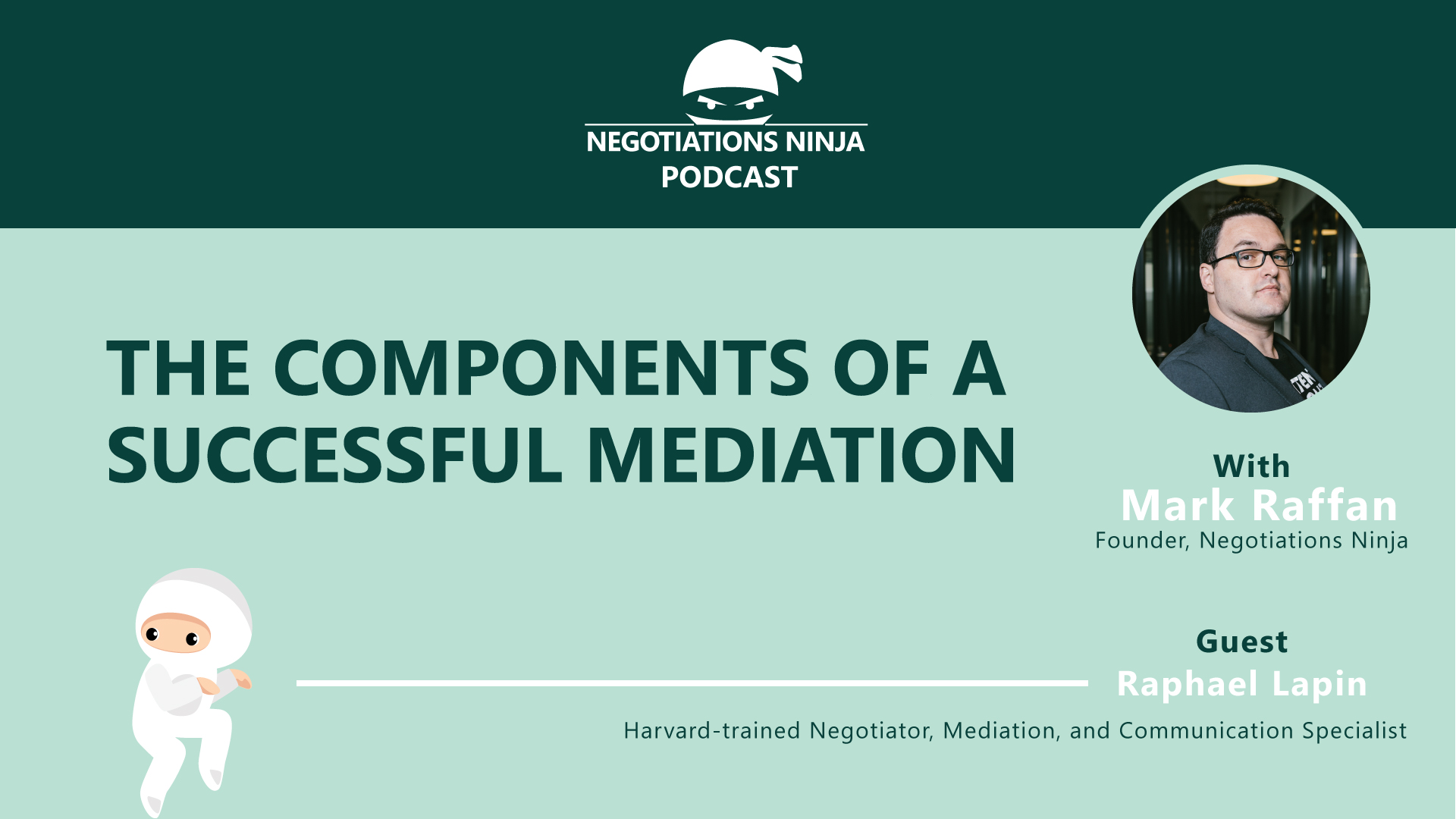What are the necessary ingredients that make for a successful mediation? Is there a difference between a great mediation and an average mediation? How is mediation different from arbitration and litigation? Harvard-trained negotiator, mediation, and communication specialist Raphael Lapin shares his expert opinion in this episode of Negotiations Ninja.
NOTE: None of this is legal advice. Always seek the counsel of a qualified attorney. This is meant for informational purposes only.
Outline of This Episode
- [1:50] Learn more about Raphael Lapin
- [4:52] Raphael’s negotiation strategies monthly column
- [6:40] The difference between arbitration and mediation
- [13:43] Raphael’s process as a dispute mediator
- [18:56] How to understand the interests of the other party
- [22:25] A mediation is an evolutionary process
- [27:40] How to get each party to follow through on their commitment
- [29:15] How some people abuse the mediation process
- [34:37] How to connect with Raphael Lapin
Raphael’s process as a dispute mediator
Parties often want to resolve a dispute before proceeding to litigation. When Raphael facilitates conversation as a mediator, what does his process look like? How does he make it as productive as possible?
Raphael notes that he tries to get his mindset to a place where he understands that both parties see things in a way that makes sense to each of them (based on their needs, concerns, and fears). It filters through how they process information. Raphael can hear both sides and understand where each is coming from.
The difference between understanding and agreeing
In any dispute or debate, people see things dogmatically from their perspective. They each remain in their perspective and there’s never an exchange. Raphael believes that part of that emerges from the fact that people confuse understanding with agreeing.
Raphael makes an effort to understand each side. He’ll argue the case more compellingly than they can argue himself to prove he understands—but not that he agrees. He’s asking them to put themselves in the other person’s shoes. How are they seeing it? He facilitates that understanding to make sure parties realize they can understand each side without necessarily agreeing.
Roger Fisher wrote “Getting to Yes,” before he passed away. He used to argue cases in front of the supreme court. He would start by arguing his opponent’s case more eloquently than they ever could. The judges would often be confused and question what side he was on. He would go on to say, “There is a different way of looking at this,” and then would present his case. It’s a compelling technique that can move parties toward understanding each other. What else facilitates the process of understanding?
How to understand the interests of the other party
People are dogmatic about what they believe in. When people are negotiating, they have a religious adherence to their viewpoint. How does Raphael help them understand the interests of the other party?
He believes that you need to “loosen the earth” around their positions and help them become less rigid. It’s important to work to determine what the party’s position is. Someone may say they want $100,000 for something. It’s a solution, but what is the party really looking for? Fair compensation.
Fair compensation can be provided in lieu of the $100,000. It could look like offering work on future projects. The position of demanding $100,000 is only one possible solution. Once Raphael understands the underlying problem, he can use active listening to reframe their position into something more useful and less rigid.
He also creates alternative options to solve the ultimate problem. Raphael points out that people always say “make us an offer,” which you don’t want to do. Why? Because then you’re negotiating against yourself. They always present multiple equivalent simultaneous solutions.
How to get each party to follow through on their commitment
In some mediations, they’ll come to a result in the meeting. If they do, they write up an agreement for both parties to sign—even if it’s just on the back of a napkin. If resolution doesn’t happen in the meeting, Raphael can still see that there is room for an agreement. He will continue working with them toward an agreement outside of the initial conversation.
He’ll summarize conversations in emails until they reach an agreement. Once they do, he will always make sure something is signed. In the past, attorneys have told Raphael, “Thank you, we’ve got it from here.” The truth is, they haven’t. Nine times out of ten they mess something up. So he never leaves it to the attorneys until something has been signed.
Resources & People Mentioned
- Getting to Yes by Robert Fisher and William Ury
Connect with Raphael Lapin
- Lapin Negotiation Services
- Sign up for Raphael’s newsletter
- Watch Raphael’s videos on YouTube
Connect With Mark
- Follow Negotiations Ninja on Twitter: @NegotiationPod
- Connect with Mark on LinkedIn
- Follow Negotiations Ninja on LinkedIn
- Connect on Instagram: @NegotiationPod
- negotiations.ninja




